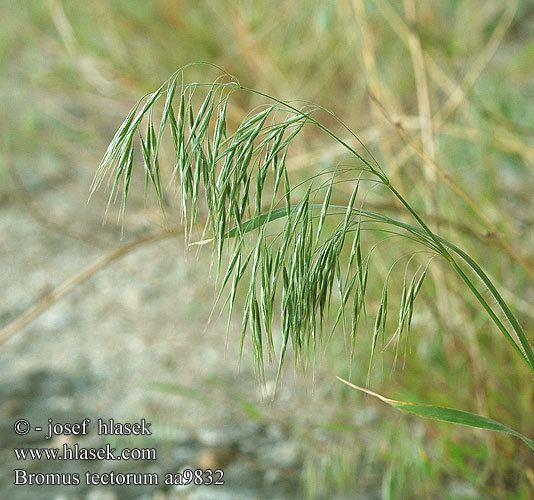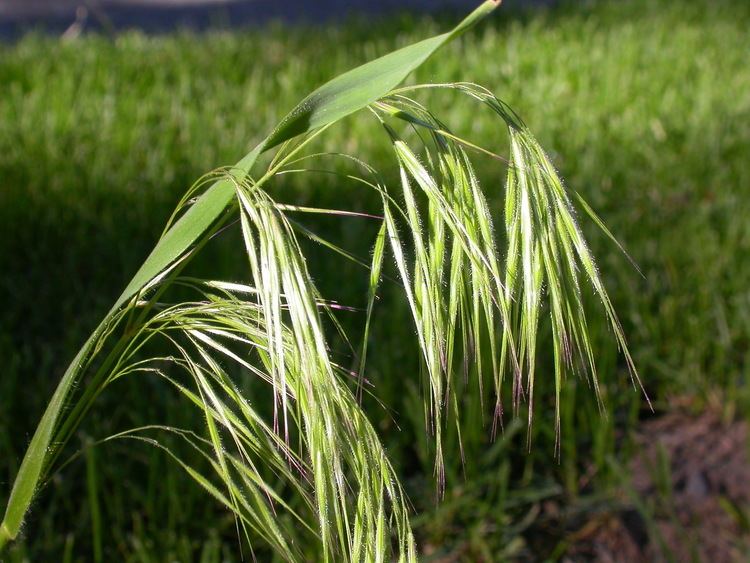Rank Species | Genus Bromus Higher classification Bromus | |
 | ||
Similar Bromus, Grasses, Sagebrush, Pseudoroegneria spicata, Taeniatherum caput‑medusae | ||
Cheatgrass bromus tectorum die offs near winnemucca nevada 1985 2015
Bromus tectorum, known as drooping brome or cheat grass, is a grass native to Europe, southwestern Asia and northern Africa, but has become invasive in many other areas.
Contents
- Cheatgrass bromus tectorum die offs near winnemucca nevada 1985 2015
- Description
- Seeds
- Habitat
- Status as an exotic weed
- Invasive species
- References

Description

Bromus tectorum is an annual bunchgrass, usually germinating in autumn, overwintering as a seedling, then flowering in the spring or early summer. If winter rainfall is limiting and spring moisture is adequate, the seeds will germinate in the spring, and the plants will flower that summer. It typically reaches 40–90 centimetres (16–35 in) tall, though plants as small as 2.5 centimetres (0.98 in) may produce seed. It is cleistogamous and self-fertile, with no evident out-crossing.

It has an extensive root system. The wide-spreading lateral roots are one of the keys to the survival of this plant. A study showed that it had the capability to reduce soil moisture to the permanent wilting point to a depth of 70 centimetres (28 in), reducing competition from other species.
Seeds

The seeds are dispersed by wind, small rodents, or attachment to animal fur, within a week of maturity. They are also moved as a contaminant in hay, grain, straw, and machinery. It is an abundant seed producer, with a potential in excess of 300 seeds per plant; seed production per plant is dependent on plant density. Under optimal conditions, it may produce 450 kg of seed per hectare (400 pounds per acre) with about 330,000 seeds/kg (150,000 seeds/pound).

The seeds maintain high viability in dry storage, lasting over 11 years. In the field, under buried conditions, seeds will lose their viability in 2–5 years. The primary limit to germination is inadequate moisture. Seeds can withstand high soil temperatures. Germination is best in the dark or in diffuse light. They germinate most quickly when covered with soil, but do not need to be in contact with bare soil; some leaf litter cover will generally improve germination and establishment of seedlings. Seedlings emerge rapidly from the top 2.5 cm (1") of soil, and a few plants emerge from depths of 8 cm (3"), but not from seeds 10 cm (4") below the surface.
Habitat
Bromus tectorum grows in many climatic areas. It is found primarily in the 150–560 millimetres (5.9–22.0 in) precipitation zone. It will grow in almost any type of soil, including B and C horizons of eroded areas and areas low in nitrogen. It is most often found on coarse-textured soils and does not grow well on heavy, dry, and/or saline soils. It grows in a relatively narrow range of soil temperatures; growth starts at 2.0–3.5 °C (35.6–38.3 °F) and slows when temperatures exceed 15 °C (59 °F).
Status as an exotic weed
Drooping brome has been introduced to southern Russia, west central Asia, North America, Japan, South Africa, Australia, New Zealand, Iceland, and Greenland. It was first found in the United States (where it is known as downy brome or cheatgrass) in 1861 in New York and Pennsylvania, by 1928 reaching throughout the United States (including Hawaii and Alaska), except for Florida and portions of Alabama, Georgia, South Carolina; it is most abundant in the Great Basin, Columbia Basin, and part of the introduced species that replaced California native plants in the Floristic Province's grasslands and other habitats.
Invasive species
In the US, it grows on rangelands, pastures, prairies, fields, waste areas, eroded sites, and roadsides. It is much reviled by ranchers and land managers. Drooping brome seeds are also a critical portion of the diet of the chukar and grey partridge which have been introduced to the US. Intensive sheep browsing of cheatgrass in early spring has been used as a fire fuels reduction strategy in the hills adjacent to Carson City, Nevada.
The presence of biological soil crusts may slow the establishment of Bromus.
Drooping brome has demonstrated a quantitative and qualitative response to recent and near-term changes in the concentration of atmospheric carbon dioxide. Laboratory experiments have shown that above-ground biomass increased 1.5–2.7 gram per plant for every 10 part per million (ppm) increase above the 270 ppm pre-industrial baseline. On the qualitative side, rising carbon dioxide decreased the digestibility and potential decomposition of drooping brome. In addition to stimulation of biomass, rising carbon dioxide may also increase the above ground retention of drooping brome biomass by decreasing removal by animals or bacteria. Ongoing increases in atmospheric carbon dioxide may contribute significantly to drooping brome productivity and fuel load with subsequent effects on wildfire frequency and intensity.
B. tectorum has been shown to benefit from endophytic colonization by morels (Morchella sextelata, M. snyderi) in western North America.
